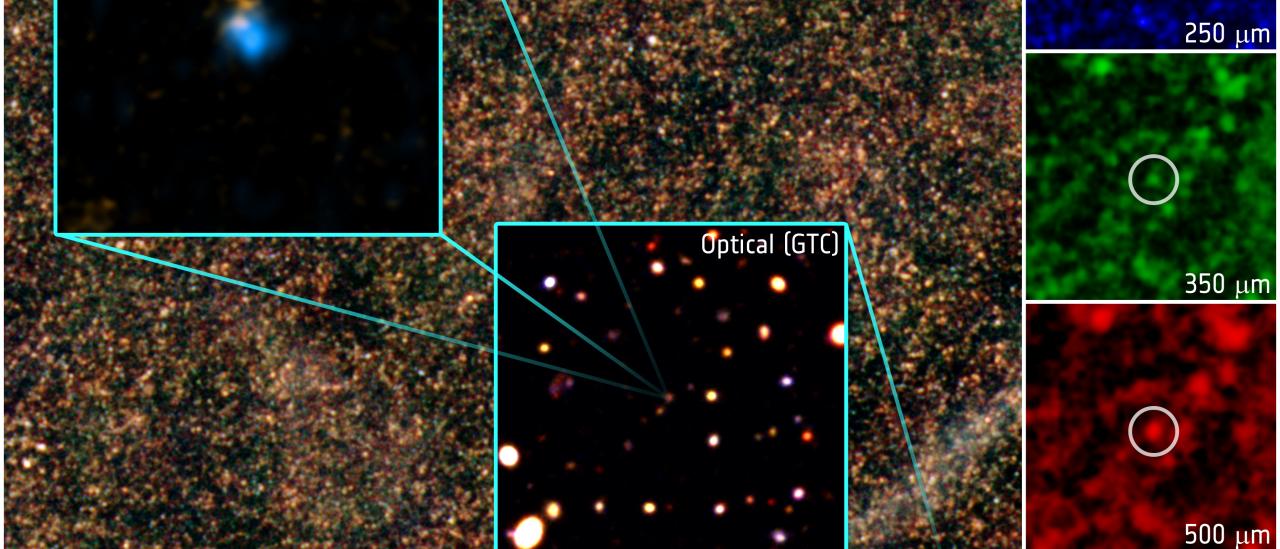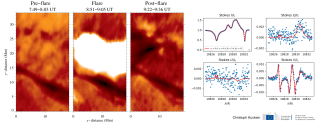Subvenciones relacionadas:
General
Este grupo desarrolla varios proyectos extragalácticos en diferentes rangos del espectro electromagnético utilizando satélites y telescopios en tierra para estudiar la evolución cosmológica de las galaxias y el origen de la actividad nuclear en galaxias activas. En el aspecto instrumental, el grupo forma parte del consorcio internacional que ha construido el instrumento SPIRE del Observatorio Espacial Herschel y del consorcio europeo que desarrolla el instrumento SAFARI para el telescopio espacial infrarrojo SPICA de las agencias espaciales ESA y JAXA.
Los proyectos principales en 2018 han sido:
a) Galaxias y cuásares distantes con emisión en el infrarrojo lejano descubiertas con el Observatorio Espacial Herschel en los "Key Projects" HerMES y Herschel-ATLAS.
b) Sloan Digital Sky Survey IV: galaxias del proyecto BELLS GALLERY y galaxias Lyman alpha muy luminosas
c) Participación en el desarrollo del instrumento SAFARI, una de las contribuciones europeas al telescopio espacial infrarrojo SPICA.
d) Descubrimiento de la estrella individual más distante conocida, en uno de los campos del proyecto "HST Frontier Fields"
e) Búsqueda de supernovas en galaxias distantes amplificadas por lentes gravitacionales.
f) Varios estudios con GTC de sistemas de absorción en la línea de visión a cuásares rojos.
Miembros
Resultados
- Marques-Chaves et al. (2018) presentan un estudio detallado de la galaxia submm HLock01 a z = 2.9574, una de las fuentes más brillantes magnificadas por una lente gravitacional descubiertas en el "Herschel Multi-tiered Extragalactic Survey".
- Rigopoulou et al. (2018) derivan la metalicidad de la fase gaseosa de la galaxia submm HLSW-01 utilizando observaciones espectroscópicas de líneas de estructura fina con Herschel. Encuentran que la metalicidad de galaxias submm luminosas es de tipo solar y que siguen la relación masa-metalicidad esperada para galaxias a z ∼ 3.
- Cornachione et al. (2018) presentan un estudio morfológico de 17 galaxias emisoras Lyman alpha magnificadas por lentes gravitacionales de la muestra BELLS GALLERY. El análisis combina el efecto de magnificación de las lentes fuertes galaxia-galaxia con la alta resolución angular del telescopio espacial Hubble para conseguir una resolución espacial de ~80 pc.
- Oteo et al. (2018) reportan la identificación de un protocúmulo de galaxias extremo en el universo temprano cuyo núcleo (denominado Núcleo Rojo Distante por su color muy rojo en las bandas de Herschel SPIRE) está formado por al menos 10 galaxias polvorientas con formación estelar, confirmadas espectroscópicamente a z = 4.002 con ALMA y ATCA.
- Kelly et al. (2018) reportan el descubrimiento de una estrella individual, Icarus, a un desplazamiento al rojo de 1.49, magnificada más de 2000 veces por el efecto de lente gravitacional del cúmulo de galaxias MACS J1149+222. Icarus está localizada en una galaxia espiral muy alejada de la tierra, su luz ha tardado 9000 millones de años en llegar a la tierra.
Actividad científica
Publicaciones relacionadas
-
The Evolution of Spiral, S0, and Elliptical Galaxies in Clusters
We quantify the evolution of the spiral, S0 and elliptical fractions in galaxy clusters as a function of cluster velocity dispersion (σ) and X-ray luminosity (LX ) using a new database of 72 nearby clusters from the Wide-Field Nearby Galaxy-Cluster Survey (WINGS) combined with literature data at z = 0.5-1.2. Most WINGS clusters have σ between 500
Poggianti, Bianca M. et al.Fecha de publicación:
62009 -
Superdense Massive Galaxies in Wings Local Clusters
Massive quiescent galaxies at z > 1 have been found to have small physical sizes, and hence to be superdense. Several mechanisms, including minor mergers, have been proposed for increasing galaxy sizes from high- to low-z. We search for superdense massive galaxies in the WIde-field Nearby Galaxy-cluster Survey (WINGS) of X-ray selected galaxy
Valentinuzzi, T. et al.Fecha de publicación:
32010 -
Spitzer 70 and 160 μm Observations of the COSMOS Field
We present Spitzer 70 and 160 μm observations of the COSMOS Spitzer survey (S-COSMOS). The data processing techniques are discussed for the publicly released products consisting of images and source catalogs. We present accurate 70 and 160 μm source counts of the COSMOS field and find reasonable agreement with measurements in other fields and with
Frayer, D. T. et al.Fecha de publicación:
112009 -
The shapes of BCGs and normal ellipticals in nearby clusters
We compare the apparent axial ratio distributions of the brightest cluster galaxies (BCGs) and normal ellipticals (Es) in our sample of 75 galaxy clusters from the WIde-field Nearby Galaxy-cluster Survey (WINGS). Most BCGs in our clusters (69 per cent) are classified as cD galaxies. The sample of cDs has been completed by 14 additional cDs (non
Fasano, G. et al.Fecha de publicación:
52010 -
Superdense Massive Galaxies in the ESO Distant Cluster Survey (EDisCS)
We find a significant number of massive and compact galaxies in clusters from the ESO Distant Clusters Survey (EDisCS) at 0.4 < z < 1. They have similar stellar masses, ages, sizes, and axial ratios to local z ~ 0.04 compact galaxies in WIde field Nearby Galaxy clusters Survey (WINGS) clusters, and to z = 1.4-2 massive and passive galaxies found in
Valentinuzzi, T. et al.Fecha de publicación:
92010 -
Specific star formation and the relation to stellar mass from 0 < z < 2 as seen in the far-infrared at 70 and 160 μm
We use the Spitzer Wide-area InfraRed Extragalactic Legacy Survey (SWIRE) to explore the specific star formation activity of galaxies and their evolution near the peak of the cosmic far-infrared (FIR) background at 70 and 160 μm. We use a stacking analysis to determine the mean FIR properties of well-defined subsets of galaxies at flux levels well
Oliver, Seb et al.Fecha de publicación:
72010 -
Herschel-ATLAS: the far-infrared-radio correlation at z < 0.5
We use data from the Herschel-ATLAS to investigate the evolution of the far-infrared-radio correlation over the redshift range 0 < z < 0.5. Using the total far-infrared luminosity of all >5σ sources in the Herschel-ATLAS Science Demonstration Field and cross-matching these data with radio data from the Faint Images of the Radio Sky at Twenty
Jarvis, Matt J. et al.Fecha de publicación:
112010 -
Herschel-ATLAS: The dust energy balance in the edge-on spiral galaxy UGC 4754
We use Herschel PACS and SPIRE observations of the edge-on spiral galaxy UGC 4754, taken as part of the H-ATLAS SDP observations, to investigate the dust energy balance in this galaxy. We build detailed SKIRT radiative models based on SDSS and UKIDSS maps and use these models to predict the far-infrared emission. We find that our radiative transfer
Baes, M. et al.Fecha de publicación:
72010 -
Herschel-ATLAS: The angular correlation function of submillimetre galaxies at high and low redshift
We present measurements of the angular correlation function of galaxies selected from the first field of the H-ATLAS survey. Careful removal of the background from galactic cirrus is essential, and currently dominates the uncertainty in our measurements. For our 250 μm-selected sample we detect no significant clustering, consistent with the
Maddox, S. J. et al.Fecha de publicación:
72010 -
Herschel-ATLAS: far-infrared properties of radio-selected galaxies
We use the Herschel-Astrophysical Terahertz Large Area Survey (ATLAS) science demonstration data to investigate the star formation properties of radio-selected galaxies in the GAMA-9h field as a function of radio luminosity and redshift. Radio selection at the lowest radio luminosities, as expected, selects mostly starburst galaxies. At higher
Hardcastle, M. J. et al.Fecha de publicación:
112010 -
Herschel-ATLAS: Extragalactic number counts from 250 to 500 microns
Aims: The Herschel-ATLAS survey (H-ATLAS) will be the largest area survey to be undertaken by the Herschel Space Observatory. It will cover 550 sq. deg. of extragalactic sky at wavelengths of 100, 160, 250, 350 and 500 μm when completed, reaching flux limits (5σ) from 32 to 145 mJy. We here present galaxy number counts obtained for SPIRE
Clements, D. L. et al.Fecha de publicación:
72010 -
Herschel-ATLAS: Evolution of the 250 µm luminosity function out to z = 0.5
We have determined the luminosity function of 250 μm-selected galaxies detected in the ~14 deg2 science demonstration region of the Herschel-ATLAS project out to a redshift of z = 0.5. Our findings very clearly show that the luminosity function evolves steadily out to this redshift. By selecting a sub-group of sources within a fixed luminosity
Dye, S. et al.Fecha de publicación:
72010 -
Herschel-ATLAS: Dust temperature and redshift distribution of SPIRE and PACS detected sources using submillimetre colours
We present colour-colour diagrams of detected sources in the Herschel-ATLAS science demonstration field from 100 to 500 μm using both PACS and SPIRE. We fit isothermal modified black bodies to the spectral energy distribution (SED) to extract the dust temperature of sources with counterparts in Galaxy And Mass Assembly (GAMA) or SDSS surveys with
Amblard, A. et al.Fecha de publicación:
72010 -
Herschel-ATLAS: Blazars in the science demonstration phase field
To investigate the poorly constrained sub-mm counts and spectral properties of blazars we searched for these in the Herschel-ATLAS (H-ATLAS) science demonstration phase (SDP) survey catalog. We cross-matched 500 μm sources brighter than 50 mJy with the FIRST radio catalogue. We found two blazars, both previously known. Our study is among the first
González-Nuevo, J. et al.Fecha de publicación:
72010 -
Herschel ATLAS: The cosmic star formation history of quasar host galaxies
We present a derivation of the star formation rate per comoving volume of quasar host galaxies, derived from stacking analyses of far-infrared to mm-wave photometry of quasars with redshifts 0 < z < 6 and absolute I-band magnitudes -22 > IAB > -32 We use the science demonstration observations of the first ~16 deg2 from the Herschel Astrophysical
Serjeant, S. et al.Fecha de publicación:
72010 -
H-ATLAS: PACS imaging for the Science Demonstration Phase
We describe the reduction of data taken with the PACS instrument on board the Herschel Space Observatory in the Science Demonstration Phase of the Herschel-ATLAS (H-ATLAS) survey, specifically data obtained for a 4 × 4 deg2 region using Herschel's fast-scan (60arcsecs-1) parallel mode. We describe in detail a pipeline for data reduction using
Ibar, Edo et al.Fecha de publicación:
112010 -
A search for debris disks in the Herschel-ATLAS
Aims: We aim to demonstrate that the Herschel-ATLAS (H-ATLAS) is suitable for a blind and unbiased survey for debris disks by identifying candidate debris disks associated with main sequence stars in the initial science demonstration field of the survey. We show that H-ATLAS reveals a population of far-infrared/sub-mm sources that are associated
Thompson, M. A. et al.Fecha de publicación:
72010 -
WINGS-SPE II: A catalog of stellar ages and star formation histories, stellar masses and dust extinction values for local clusters galaxies
Context. The WIde-field Nearby Galaxy clusters Survey (wings) is a project whose primary goal is to study the galaxy populations in clusters in the local universe (z < 0.07) and of the influence of environment on their stellar populations. This survey has provided the astronomical community with a high quality set of photometric and spectroscopic
Fritz, J. et al.Fecha de publicación:
22011 -
Which haloes host Herschel-ATLAS galaxies in the local Universe?
We measure the projected cross-correlation between low-redshift (z < 0.5) far-infrared selected galaxies in the science demonstration phase (SDP) field of the Herschel-ATLAS (H-ATLAS) survey and optically selected galaxies from the Galaxy and Mass Assembly (GAMA) redshift survey. In order to obtain robust correlation functions, we restrict the
Guo, Qi et al.Fecha de publicación:
42011 -
The first release of data from the Herschel ATLAS: the SPIRE images
We have reduced the data taken with the Spectral and Photometric Imaging Receiver (SPIRE) photometer on board the Herschel Space Observatory in the Science Demonstration Phase (SDP) of the Herschel Astrophysical Terahertz Large Area Survey (H-ATLAS). We describe the data reduction, which poses specific challenges, both because of the large number
Pascale, E. et al.Fecha de publicación:
72011


